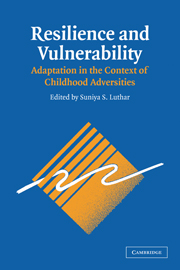Book contents
- Frontmatter
- Contents
- List of Contributors
- Foreword by Dante Cicchetti
- Preface
- 1 A Resilience Framework for Research, Policy, and Practice
- PART I FAMILIAL ADVERSITIES: PARENTAL PSYCHOPATHOLOGY AND FAMILY PROCESSES
- PART II EXOSYSTEMIC AND SOCIODEMOGRAPHIC RISKS
- 10 Rethinking Resilience: A Developmental Process Perspective
- 11 Poverty and Early Childhood Adjustment
- 12 Emerging Perspectives on Context Specificity of Children's Adaptation and Resilience: Evidence from a Decade of Research with Urban Children in Adversity
- 13 Holistic Contextual Perspectives on Risk, Protection, and Competence among Low-Income Urban Adolescents
- 14 Overcoming the Odds? Adolescent Development in the Context of Urban Poverty
- 15 Adaptation among Youth Facing Multiple Risks: Prospective Research Findings
- 16 Positive Adaptation among Youth Exposed to Community Violence
- 17 Perceived Discrimination and Resilience
- 18 Promoting Resilience through Early Childhood Intervention
- PART III COMMENTARIES
- Index
- References
17 - Perceived Discrimination and Resilience
Published online by Cambridge University Press: 05 June 2012
- Frontmatter
- Contents
- List of Contributors
- Foreword by Dante Cicchetti
- Preface
- 1 A Resilience Framework for Research, Policy, and Practice
- PART I FAMILIAL ADVERSITIES: PARENTAL PSYCHOPATHOLOGY AND FAMILY PROCESSES
- PART II EXOSYSTEMIC AND SOCIODEMOGRAPHIC RISKS
- 10 Rethinking Resilience: A Developmental Process Perspective
- 11 Poverty and Early Childhood Adjustment
- 12 Emerging Perspectives on Context Specificity of Children's Adaptation and Resilience: Evidence from a Decade of Research with Urban Children in Adversity
- 13 Holistic Contextual Perspectives on Risk, Protection, and Competence among Low-Income Urban Adolescents
- 14 Overcoming the Odds? Adolescent Development in the Context of Urban Poverty
- 15 Adaptation among Youth Facing Multiple Risks: Prospective Research Findings
- 16 Positive Adaptation among Youth Exposed to Community Violence
- 17 Perceived Discrimination and Resilience
- 18 Promoting Resilience through Early Childhood Intervention
- PART III COMMENTARIES
- Index
- References
Summary
On the first day of school, second grader Eduardo's Anglo classmates call him a “dirty Spic” on the playground and won't let him play basketball with them. At a middle school, in a mixed-race classroom, Juanita's teacher, Mr. Smith, yells at her when she does not turn her homework in on time. He tells her she is lazy and irresponsible.
Are Eduardo and Juanita likely to perceive these interactions as acts of racial or ethnic discrimination? Is this a common occurrence for these children? Will their feelings of having been discriminated against serve as a risk factor for poor self-esteem or depression? How do racism and discrimination fit in the overall complex development of resilience?
The past three decades have seen the study of resilience in development progress from its early conceptions of invulnerable children (Anthony & Cohler, 1987; Pines, 1975) to our present understandings of mediated and moderated paths toward resilience. We have begun to move from the identification of important individual characteristics of the invincibles (Werner & Smith, 1992) to a more systemic approach involving families, schools, and communities; from the identification of risk or protective factors to the understanding of the mechanisms that underlie these factors. Our conception of resilience as a multidimensional construct presently requires that empirical attention be paid not only to adaptational failures but also to positive adjustment, “to forces that are protective in nature as well as those that exacerbate vulnerability” in various groups (Luthar & Cicchetti, 2000, p. 878).
- Type
- Chapter
- Information
- Resilience and VulnerabilityAdaptation in the Context of Childhood Adversities, pp. 414 - 435Publisher: Cambridge University PressPrint publication year: 2003
References
- 34
- Cited by



